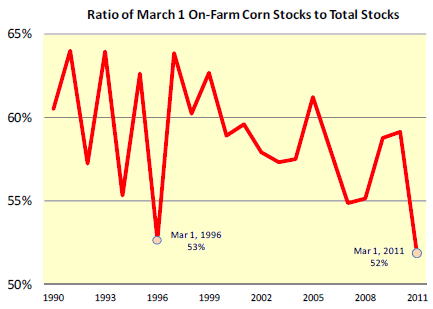



CME: Grain Futures Continue to Drive Demand
US - Grain futures left no doubt that this continues to be a demand driven market, write Steve Meyer and Len Steiner.As we noted in our previous, on the face of it, the plantings numbers were generally as expected and in some cases could be construed to be a bit on the bearish side (big gains for wheat and over 92 mil corn acres). However, trade quickly focused on the results of the quarterly grain stocks survey. Pre-report estimates were looking for total corn stocks on March 1 to be 6.69 billion bushels.

The USDA report, however, pegged the 1 March corn stocks inventory at 6.52 billion bushels. In any other year, a 170 million bushel difference would be notable but also manageable. This year, however, is not a normal year. Coming into this report, USDA was already projecting very tight ending stocks of 675 million bushels and a stocks to use ratio of just 5 per cent, the lowest since 1995/96. The stocks report shows that estimates of feed use may need to be revised. In its latest supply/demand report (10 March), USDA had pegged feed use for this marketing year at 5.2 billion bushels, just 1.2 per cent higher than the previous year. The stocks report, however, shows that high prices have yet to ration feed demand, which appears to be far outpacing the USDA estimates.

Some of the analysis we
have seen notes that, following the grains report, USDA will probably
have to bump up its total marketing year feed use by about 100 million
bushels (probably more) and maybe reduce ethanol use some to make the
balance sheet work. This would lead to a total utilization of about 13.6
billion pounds and leave ending stocks for this marketing year at a mere
575 million bushels and a stocks/use ratio of 4.2 per cent. Trade clearly is worried
that in order for this math to work, corn prices will need to be significantly
higher, thus leading to the limit up futures bids in yesterday’s
market. The issue of higher than expected feed use has been the topic of
much discussion recently.
Often we have pointed out the sharp rise in
livestock and poultry weights. While producers were uncertain about the
future and opted to keep animal numbers in check, they realized that
adding pounds (via higher feed use) was a quick way to temporarily boost supplies and benefit from record high meat prices. In
the case of cattle, poor winter wheat conditions forced calves on feed early, further increasing feed use. While feed costs were
higher than in previous years, the appreciation in meat prices did provide at the margin for some modest profits and producers
took advantage of that.
Also important to note is that the on farm stocks as of 1 March (as a percent of total stocks) were the
lowest in more than 20 years, surpassing even 1 March 1996. This again is a very bullish indicator. While higher prices will be
needed to ration out demand, the fact that a larger portion of the remaining supply is off farm clearly complicates the job. Finally,
we have not spoken at all about exports. The US dollar remains very weak and this will only support US corn exports. In all,
the situation in the corn market remains very difficult and no quick solutions are in sight.











